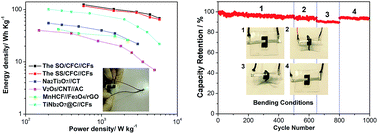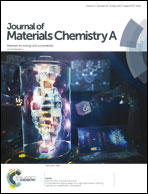High-performance sodium-ion batteries and flexible sodium-ion capacitors based on Sb2X3 (X = O, S)/carbon fiber cloth†
Abstract
Due to limited Li resources, sodium-ion batteries (NIBs) have become promising candidates for application in large-scale energy storage systems, and the development of high-performance anode materials for NIBs has become particularly urgent. Moreover, sodium-ion capacitors (NICs), which combine the characteristics of batteries and capacitors, have attracted significant research interest due to their high energy and power density. Herein, we report the design of efficient hydrothermal routes for synthesizing interlaced Sb2O3 nanosheets and Sb2S3 micro-nanospheres, grown on carbon fiber cloth, referred to as SO/CFC and SS/CFC, respectively, which were then used as flexible electrodes for NIBs and NICs devices. For NIBs applications, the SO/CFC electrodes exhibit a high stable capacity of 514 mA h g−1 after 500 cycles at 0.5 A g−1. The SS/CFC electrodes also display a stable capacity of 736 mA h g−1 after 650 cycles at 0.5 A g−1 and the high-rate capability can reach a high current density of 15 A g−1. Importantly, the flexible NIC device based on SO/CFC or SS/CFC as the anode and carbon fibers as the cathode was demonstrated, which manifests high power density and energy density, as well as significantly superior cycle stability.



 Please wait while we load your content...
Please wait while we load your content...